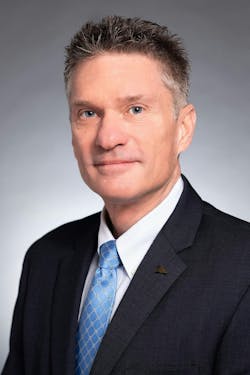2025 Mid-Year Outlook: What HVACR Contractors Should Know
The first half of 2025 has been a perfect storm for the HVACR industry as contractors have navigated tariffs, shifting regulations, evolving technologies, and consumer caution.
To get a clearer picture of where things stand — and where they're headed — Contracting Business spoke with leading OEMs to gain insights on the biggest challenges and opportunities facing the industry today. Shane Angle, vice president, sales and technical services, Copeland; Scot Swan, business manager, Arkema; Doug Widenmann, senior vice president of marketing, Daikin Comfort Technologies North America; and Randy Roberts, vice president, Residential, Rheem Air Conditioning Division, offer mid-year perspectives and valuable guidance for contractors planning the months ahead.
CB: Are you seeing increased pricing for HVAC systems with the current economic climate and Tariffs in place, and how is that affecting demand?
Angle: We’ve seen only marginal pricing increases from tariffs so far. Overall, the pricing of HVAC systems has increased significantly over the past five years, starting with the supply chain challenges brought on by COVID-19. Also, remember that this is the first year of a transition in residential air conditioning. Since Jan. 1, 2025, all new units produced have been optimized for A2L refrigerants, resulting in a slight additional price increase due to the design changes needed.
Since the start of April, we have seen additional system price increases in the 5% to 10% range due to tariff uncertainty. We could anticipate additional increases depending on how the negotiations on reciprocal tariffs with China play out.
It’s too soon to know if there may be an impact on demand, although the price increases over the last five years haven’t had a dramatic effect. If air conditioning or heating units break, consumers will get them fixed, whether it's a system repair or replacement.
That said, we do anticipate a potential shift in the repair-replace decision this year. One reason is the economic uncertainty and price increases. We’ve also historically seen some resistance during refrigerant transitions to embrace the new, optimized units. So, some may upgrade to a new R-410A compressor as a cost-effective measure for keeping an existing system running.
Copeland has prepared for either scenario by preparing for the refrigerant shift with a full lineup of A2L-optimized compression options. We’ve also recently introduced a line of Copeland LXE service compressors that consolidate R-410A compressors (i.e., ZP**KA/KV/K5/K6/K7) into one platform. Not only is this platform optimized to be our most efficient R-410A compressor, but it also helps ensure availability at the point of service, simplifies support of legacy refrigerant compressor-based systems, and reduces the number of SKUs for our distribution partners.
Roberts: Due to the current economic climate and tariffs, Rheem is seeing increased costs for raw materials and components used to build HVAC equipment. While these cost pressures are a reality, so far, it hasn’t had a direct impact on demand.
Widenmann: Yes, various OEMs have announced price adjustments in response to the global trade situation. We have announced price adjustments and continue to monitor the situation very closely. However, we believe there are other factors also affecting demand, such as other OEM’s A2L refrigerant transition, that appear to be an opportunity for Daikin.
CB: How are you managing supply chain disruptions to ensure contractors and distributors receive equipment on time?
Roberts: While Rheem is seeing some supply chain disruptions, particularly as suppliers adjust production locations to navigate tariff impacts, the company has taken proactive steps to minimize delays. With multiple vendors, Rheem has built flexibility into its supply chain, allowing the company to better manage through potential disruptions and continue delivering equipment to contractors and distributors on time.
Widenmann: Daikin has been working on various strategies since the supply disruption the industry experienced beginning in 2022. We believe that our state-of-the-art manufacturing facility, Daikin Texas Technology Park, in Waller, Texas, our comparable logistics operations at Daikin, and our supplier localization efforts are well situated to meet the anticipated growth opportunities ahead of us. Also, choosing to transition to R-32, ahead of many other OEMs with R-454B, has allowed us to strengthen our inventory position with a proven, available, low-cost refrigerant, compared to other available low-GWP refrigerants used in residential and light-commercial systems.
Angle: Mitigating supply chain disruptions has been a longstanding area of continued focus and commitment for our business. We’ve made strategic investments in our supply chain and inventories to help ensure we continue improving resiliency and redundancy to protect against potential supply chain disruptions. Over the last decade, we’ve identified opportunities to invest in regionalizing our supply base in North America, reducing reliance on foreign suppliers, and establishing strategic regional locations of factories and assembly plants. These efforts will continue.
Today, we have manufacturing plants in over 25 facilities worldwide, including in the U.S., India, East Asia and Mexico. This broad footprint allows us to stay close to customers and ensure faster lead times.
CB: How is the transition to A2L refrigerants progressing, and are there any supply chain concerns affecting availability?
Swan: The transition was delayed due to OEMs producing R-410A equipment later in 2024 than originally expected. Now, it’s likely that R-410A equipment will not be sold through until mid-2025. So we expect that the new equipment will become increasingly available later in 2025. To our knowledge, those who are using R-32 equipment are not experiencing supply chain issues.
The industry was well aware of the move to A2L refrigerants for a number of years, but there has been uncertainty on exactly when OEMs would transition their product lines. Presently, the supply chain pipeline for A2L refrigerants is being filled. In the case of R-32, because there was an earlier start, the product is more readily available.
CB: What steps are refrigerant manufacturers taking to ensure contractors have adequate access to A2Ls during the transition?
Swan: Arkema has been preparing for this transition for several years. It started with our OEM partners. More recently, we’ve worked with our package suppliers to ensure we could meet market demand for R-32. Finally, we continue to work with knowledgeable others, such as ACCA, to ensure contractors have the training they need to work safely with A2Ls.
CB: With the Trump administration focusing on deregulation, are decarbonization and electrification still major trends in the HVACR industry? Why or why not?
Widenmann: Absolutely. Much of the activity to advance heat pump deployment in the past few years has been driven at the state level versus federal level. While the federal government may be unlikely to pursue a decarbonization/electrification strategy in the next four years, we think that it could result in more aggressive action at the state level.
Angle: Decarbonization and electrification are significant global trends, regardless of what’s happening politically in the U.S. As an international company, we serve a global economy. Thus, worldwide transitions — including decarbonization and electrification efforts — will continue to guide our business.
In the U.S., decarbonization and electrification are also being led at the state level. So, even if the federal government retracts efforts, we would anticipate states to fill those gaps, and in some cases, propose and implement additional efforts.
The HVACR industry relies on certainty and predictability to make the necessary investments to ensure these advancements continue. Equipment manufacturers must always consider their customers’ best interests, which means balancing safety, reliability and cost-effectiveness of their products while transitioning to next-gen technologies. Thus, pace and timing are paramount when establishing and implementing guidelines and rulemaking, including those around electrification and decarbonization.
Roberts: Yes, decarbonization and electrification remain major trends in the HVACR industry. While regulatory environments can influence the pace of certain initiatives, the drive toward lower carbon emissions and more energy-efficient systems is being driven by consumer wants. Commercial building owners and residential customers are prioritizing energy-efficient HVAC/R solutions for environmental reasons and long-term cost savings.
At Rheem, we're committed to innovation that supports decarbonization and electrification. This includes expanding our portfolio of high-efficiency, low-emissions equipment and investing in training to ensure contractors are equipped and understand the latest sustainable product offerings. In addition, Rheem will continue to invest in its gas product lines to be ready no matter which direction the market shifts. We also see dual-fuel solutions as a great method to move into a heat pump solution for markets that were historically gas.
Swan: It’s likely to continue to be a major trend, especially for air-sourced heat pumps. It will vary more so at a state by state level in terms of newer technologies like air-to-water heat pumps and heat pump water heaters. These technologies are much more dependent on state and/or federal incentives.
CB: What is the largest trend impacting the HVACR industry to date, and what is driving that trend?
Angle: The most significant trend impacting the HVACR industry has been transitioning from legacy hydrofluorocarbon (HFC) refrigerants to lower-global warming potential (GWP) alternatives. Today, contractors are beginning to install new residential air conditioning and heat pump equipment optimized for A2L refrigerants. However, the cumulative workload, effort, capital and resource investments needed to make these units available have been monumental. Our industry has worked overtime for two to three years to prepare for this transition.
Meanwhile, preparations are underway to transition refrigerants such as A2Ls, CO2 and R-290 in many more U.S. HVACR sectors over the next several years. This is not the first refrigerant transition our industry has seen, but it’s the first time it’s happened at such a large scale and over a short period of time — and it’s all part of a global HFC phasedown.
The refrigerant transition is also happening while the global economy sets decarbonization and electrification goals. Copeland actively invests in and supports the energy transition from gas-powered space and water heating systems to electric heat pump technologies. This global megatrend is already underway, but we anticipate it to become a much larger focus over the next decade and beyond.
Roberts: One of the largest trends currently impacting the HVAC/R industry is the transition to A2L refrigerants, and it’s reshaping everything from product design to contractor training. For OEMs, this has meant reengineering systems to safely accommodate A2Ls without compromising performance or reliability. For contractors and technicians, it means adapting to new tools, safety standards and certification requirements. The A2L transition is part of a broader industry push toward decarbonization and electrification, and Rheem has been at the forefront of this transition for years.
Swan: Regulations are still the most impactful force in the industry. For instance, DOE standards may be relaxed but the industry is still working to catch up. EPA regulations on refrigerants may or may not be relaxed which could heavily impact the level of adoption of next generation refrigerants.
Rapid changes in Regulations are still the number one challenge whether at the Federal level or the state level.
Widenmann: There are a few different trends, of which some are short term and others are long term. In the short term, the refrigerant transition is currently on every manufacturer’s, distributor’s, and contractor’s mind. Daikin made many tough choices and made what we consider the harder right decisions when it came to reengineering our new products to obtain optimal performance from the new R-32 low global warming potential refrigerant – we have redesigned every product while providing technology advancements and industry exclusive products for North America. Daikin has and continues to be a leader in technological advancements in inverter technology worldwide and in North America which has led to the current and anticipated continued shift from fossil fuel burning gas furnaces to electrification with advances in inverter heat pump technology.
CB: How are you seeing consumer preferences shift in terms of efficiency, smart technology, and indoor air quality?
Angle: We’re seeing an increased interest in smart technology, such as residential and commercial Wi-Fi thermostats, to help consumers increase system efficiency and improve indoor air quality (IAQ). Smart thermostats are enabling the development of connected HVAC systems that can be controlled and monitored remotely, provide interoperability with system peripherals, and communicate with utilities to participate in energy management and demand response programs.
Copeland’s voice-of-the-customer research shows that lowering heating/cooling costs is the primary driver for choosing a smart thermostat. Copeland’s Sensi and Verdant smart thermostats can automate HVAC schedules via setpoint setbacks using a user-friendly interface, a proven strategy for lowering energy costs. Our research also shows that consumers are equally concerned about IAQ, so the ability to keep air clean and free of pollutants is becoming a more important driver. Smart thermostats help optimize these goals while providing alerts when temperature and humidity drift out of set parameters.
We’re also supporting the development of dedicated outdoor air systems (DOAS) to improve energy efficiency and IAQ in commercial buildings. Our new HMX liquid desiccant module technology offers breakthroughs in dehumidification while enhancing comfort, efficiency, reliability, and IAQ. Copeland’s innovative HMX technology eliminates the risks of airstream cross-contamination and delivers precise control over water and desiccant flow for optimized cooling and dehumidification.
Technologies, such as Copeland’s highly efficient scroll compression and HMX solutions, deliver long-term reliability with consistent energy savings, helping consumers to lower the total cost of ownership (TCO) and accelerate their return on investment (ROI).
For residential consumers, technology improvements must address their expectations for enhancing comfort and improving energy efficiency. Remember that nearly half of home energy usage can be attributed to heating and cooling. As residential energy efficiency and decarbonization policies drive the need for technological advancements, compression technologies continue to evolve. Copeland’s innovations in modulating compression technology provide quality-driven improvements that ensure comfort, improve efficiencies and expand homeowners' choices today and in the future.
Roberts: Smart technology has always been a “want” among consumers, and it is now shifting to a “must have” feature. Customers have come to expect remote access, system automation and performance insights from their HVAC equipment, similar to the benefits of other smart home devices. At Rheem, we’ve focused heavily on connected solutions that offer both homeowners and contractors greater visibility and control.
Efficiency has become a top driver, especially as energy costs continue to fluctuate and sustainability becomes a focus point. Indoor air quality also remains a priority, particularly post-pandemic. Homeowners are more aware than ever of what’s circulating in their air.
Widenmann: Indoor Air Quality (IAQ) rose to its peak during the pandemic as consumers were in their homes more and sought options to improve their indoor air quality. It continues to be a consumer hot point and a major part of Daikin’s growth and ongoing business and technology strategy.
Since efficiency and lowering energy costs will always be a key factor for most consumers, efficiency is a primary driver behind Daikin’s advanced development of inverter heat pump technology.
Daikin recognizes the importance of smart HVAC equipment for two main reasons. One, smart HVAC equipment is a key factor in optimizing the performance of and efficiency of today’s advanced HVAC systems and two, consumers are becoming more comfortable with and are treating their HVAC systems more like an appliance. Consumers appreciate the ability to monitor and control their HVAC system from anywhere in the world, rather than adjusting that old mercury bubble thermostat on the wall.
Realizing growth opportunities in smart HVAC technology, Daikin acquired Venstar Inc. in December 2022, a leading provider of controls and energy management systems in North America.
CB: Are there specific segments (residential, commercial, industrial) experiencing more growth or challenges?
Angle: We expect specific commercial segments to grow at above-average rates, especially in mission-critical applications like data center cooling and process chillers. The growth of high-density, AI-driven computing workloads presents unprecedented data center cooling and energy management challenges. Air- and liquid-cooling and direct-to-chip technologies are rapidly advancing to meet increasing calls for improved efficiency and lower carbon emissions in energy- and heat-intensive data centers.
The Copeland oil-free centrifugal compressor with Aero-lift™ bearing technology was designed to meet the demand for energy-efficient, lower-GWP chiller solutions in data centers. This innovative, streamlined solution reduces overall system complexity by eliminating the need for oil management and active bearing control, while delivering high-lift performance, reliability and efficiency improvements.
We also offer variable-speed scroll compression solutions with operating envelopes optimized explicitly for data center cooling applications, which can require higher-than-expected evaporating temperatures. By optimizing operating envelopes and leveraging lower-GWP refrigerants, we’re helping to improve energy efficiency and reduce carbon footprints.
Demand for process chillers is also growing in the data center supply chain due to the manufacturing build-out of semiconductors and related technologies. Copeland has a range of lower-GWP-optimized, efficient compression platforms designed to exceed process chiller original equipment manufacturers’ (OEM) reliability and energy efficiency requirements.
Global decarbonization efforts are also driving growth in the electrification of residential heating. Air-source heat pumps (ASHPs) are at the forefront of this transition, offering a viable alternative to traditional gas-powered furnace and boiler systems. Copeland’s continuous advancements in modulating compression technology are helping to expand capacity and close the comfort gaps in cold climates, enabling OEMs to develop next-generation heat pump systems that deliver reliable comfort, efficiency and sustainability.
A breadth of modulating compression technologies is essential for meeting the diversity of regional climate considerations and residential market needs, including dual-fuel heat pumps that rely on a gas-powered furnace/boiler or an electric-based backup heat source. Copeland’s highly efficient and reliable compression platforms are available in fixed-speed, two-stage and variable-speed scroll; inverter swing rotary; and variable-speed scroll with enhanced vapor injection (EVI) technologies.
Our residential offerings cover the spectrum of heat pump applications and comfort requirements, from standard and cold-climate heat pumps to dual-fuel options that provide an interim step in the transition from gas- to electric-powered heating solutions. This broad product offering effectively balances heating and cooling efficiencies across a wide range of capacity requirements.
The global industrial heat pump market is also forecast to grow exponentially over the next several years. Energy and carbon-intensive industrial processes and gas-powered heating systems are widely recognized as global targets for decarbonization and electrification. However, the demands of industrial and district heating applications are varied and cannot be met with one-size-fits-all solutions.
Copeland’s Vilter VQ95 heat pump is designed to simplify the traditionally complex process of implementing industrial heat pumps, where temperature, capacity, physical size and integration specifications are unique to each application. The solution leverages innovative single-screw technology to enable unprecedented simplicity, performance, reliability and application flexibility.
Roberts: Currently, the residential segment is experiencing significant growth, especially around high-efficiency heat pumps. In the residential areas, growth is being fueled by consumer demand for sustainability, electrification incentives and outdated system replacements. We are also seeing consumers in historical gas markets look to dual fuel solutions to incorporate the benefits of a heat pump without changing their primary fuel source.
For commercial, there is a steady demand for upgrading older buildings with new, energy-efficient systems. Regulatory compliance, like building performance standards and refrigerant changes, are also putting pressure on decision-makers to act sooner rather than later. Additionally, it’s likely we are going to have to start to rely more on BMS control systems more to run buildings as people who historically operated buildings are starting to retire, and there aren’t as many folks coming up in that line of work.
Industrial faces more challenges, especially with larger systems and complex infrastructures. Supply chain disruptions, skilled labor shortages, and higher upfront costs for electrification or decarbonization retrofits can slow adoption.
Widenmann: Within residential product trends, two things stand out. One, ductless systems are becoming more widely used due to their ease of application as a problem solver for both replacement and new construction. Daikin just introduced a new 115V ductless system which doesn’t require additional 230V electrical panel modifications for adding a new system. And the 2nd growth opportunity residentially is clearly the advancements in inverter and heat pump technology.
Commercially, there’s been a slow, but steady shift from traditional commercial rooftops and split systems to more advanced Variable Refrigerant Volume (VRV) systems, which like ductless systems, provide many opportunities for unique applications and zoning, plus, provide very high performance and efficiency.
Regarding trends within the commercial segment, we all recognize the significant growth in data centers spurred on by the AI revolution. Commercial office spaces continue to have their challenges due to sustained work from home or a hybrid occupancy environment. Residentially, I think the sale of existing homes in recent years, which may continue in the near term, has provided a headwind for the residential replacement contractors and OEMs. Existing home sales are a major contributor for and are directly related to the residential HVAC replacement demand.
CB: How do you see the HVAC market evolving over the next 1-3 years given current economic conditions?
Angle: It’s difficult to predict, but we could see an evolution in market conditions that may favor specific technologies. For example, variable refrigerant flow (VRF) systems, which were already facing headwinds with the adoption of A2Ls and concern about plumbing flammable refrigerant charges throughout a building, may now also be impacted by the China-U.S. tariff uncertainties and potential price increases. As a result, end users or contractors considering VRF systems may opt for a more traditional ducted system.
Again, we could also see a shift in the repair-replace decision, driven by potential price increases and hesitance over transitioning to a new refrigerant. In the face of these real or perceived headwinds, end users and contractors may prefer to prolong existing systems with strategic repairs.
Roberts: Over the next 1–3 years, we see the HVAC market continuing to evolve with a strong focus on efficiency, electrification and decarbonization, even as economic conditions remain uncertain. From Rheem’s perspective, we’re investing heavily in training and product innovation to help our partners navigate this evolving landscape.
Widenmann: Technology improvements in advanced energy efficiency, sustainability, decarbonization and smart, connected systems will continue to be an ongoing trend driven by higher utility costs and movement toward replacing fossil fuel based heating systems. Successful contractors will focus on value, operating cost and lifetime cost, while becoming more technologically advanced in the equipment and technology they offer as well as more advanced in how they promote affordability of more efficient HVAC systems they sell through creative lending and utilization of incentives.
CB: What advice do you have for HVAC contractors and distributors to navigate economic uncertainty?
Angle: Our best advice is to stay calm, not overreact, and not undermine our industry's technological advances and sustainability progress. We’ve experienced these economic and regulatory uncertainties before and know that the wheels turn slowly. Unlike some other sectors, HVACR products are fundamental to our ways of life — comfort cooling/heating, process cooling/heating or refrigeration — and are inherently more resilient to disruptions.
We will likely see new updates and unexpected developments over the next months, and we recommend keeping an objective viewpoint about the potential implications. For our part, Copeland is committed to mitigating supply chain disruptions with increased resiliency and redundancy, while helping the industry make sense of any changes that may be on the horizon.
Roberts: Stay informed, flexible and focused on delivering value to your customers. This means keeping up with industry changes, investing in training and staying ahead of product and regulatory shifts, like the transition to A2L refrigerants. Contractors should position themselves as trusted advisors, helping customers understand the changing landscape. Distributors should prioritize strong supplier relationships and smart inventory planning to stay ahead of market needs.
Swan: Don’t buy ahead. Recognize that if prices are too good to be true, they probably are. Make sure that you buy from reputable sources.
Widenmann: Don’t assume that how and why HVAC systems are purchased today will be the same tomorrow. Consumers are challenged, but they have not abandoned their buying preferences. They have become savvier with knowledge at their fingertips. Don’t race to the bottom with price. Yes, consumers want affordability, but they also want choices, comfort, efficiency and technology.
About the Author

Nicole Krawcke
Nicole Krawcke is the Editor-in-Chief of Contracting Business magazine. With over 10 years of B2B media experience across HVAC, plumbing, and mechanical markets, she has expertise in content creation, digital strategies, and project management. Nicole has more than 15 years of writing and editing experience and holds a bachelor’s degree in Journalism from Michigan State University.




